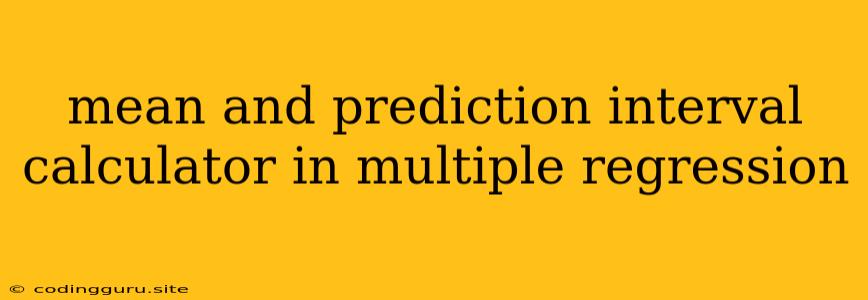Demystifying Mean and Prediction Intervals in Multiple Regression: A Comprehensive Guide
Multiple regression is a powerful statistical tool used to analyze the relationship between a dependent variable and two or more independent variables. This technique helps us understand how changes in independent variables impact the dependent variable. But it's crucial to remember that predictions made using this model are subject to uncertainty. Here's where mean and prediction intervals come into play.
What are mean and prediction intervals?
Imagine you have a multiple regression model predicting house prices based on factors like square footage, number of bedrooms, and location. Now, let's say you want to predict the price of a specific house with known characteristics. The mean interval provides a range of values within which we expect the average price of houses with those characteristics to fall. On the other hand, the prediction interval gives a range for the price of that specific house.
Why do we need both intervals?
The difference between the two intervals lies in their scope. The mean interval focuses on the average value of the dependent variable for a given set of independent variables. It tells us the expected price range of houses similar to the one in question. In contrast, the prediction interval accounts for the variability of individual data points. It captures the uncertainty associated with predicting the price of a particular house, taking into account not just the model's overall accuracy but also the random error inherent in any prediction.
How to calculate these intervals?
Calculating mean and prediction intervals in multiple regression requires understanding a few key concepts:
- Standard error of the regression (SER): This measures the overall variability of the data around the regression line.
- Standard error of the mean (SEM): This measures the variability of the average predicted value.
- Standard error of the prediction (SEP): This measures the variability of individual predictions.
The formulas for calculating these intervals involve the SER, SEM, SEP, and the t-statistic. While the exact formulas are quite complex, luckily, numerous online mean and prediction interval calculators are available that can perform these calculations for you.
Tips for interpreting the results:
- Narrower intervals mean more confidence: Smaller intervals indicate greater certainty in our predictions. Conversely, wider intervals suggest more uncertainty.
- Prediction intervals are wider than mean intervals: This reflects the additional uncertainty associated with predicting individual observations compared to the average.
- Consider the context of your data: The interpretability of these intervals depends heavily on the specific data you're working with and the accuracy of your regression model.
Example:
Let's say we are using a multiple regression model to predict the number of customers visiting a store based on variables like day of the week and advertising spend. After running the model, we obtain a mean interval of 100-150 customers for a specific day with a certain advertising spend. This means that based on our model, we expect the average number of customers on that day to fall within this range. However, for a specific prediction of customer count, we might get a prediction interval of 80-170 customers. This wider range reflects the additional uncertainty associated with predicting for a single day, considering the random fluctuations in customer behavior.
Conclusion:
Understanding mean and prediction intervals in multiple regression is crucial for interpreting the results of your analysis and communicating the level of uncertainty associated with your predictions. While online calculators can simplify the calculation process, it's essential to grasp the underlying concepts to ensure you are interpreting the intervals correctly and drawing informed conclusions from your models. By understanding the nuances of these intervals, you can make more reliable and insightful predictions based on your multiple regression analyses.
